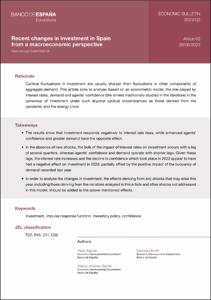Registro completo de metadatos
| Campo DC | Valor |
|---|---|
| dc.contributor.author | Aguilar, Pablo |
| dc.contributor.author | Ghirelli, Corinna |
| dc.contributor.author | Jiménez-García, Blanca |
| dc.coverage.spatial | España |
| dc.date.accessioned | 2023-07-13T12:58:57Z |
| dc.date.available | 2023-07-13T12:58:57Z |
| dc.date.issued | 2023-06-28 |
| dc.identifier.issn | 1695-9086 (en línea) |
| dc.identifier.issn | 1130-4987 (en papel) |
| dc.identifier.uri | https://repositorio.bde.es/handle/123456789/30733 |
| dc.description.abstract | Rationale Cyclical fluctuations in investment are usually sharper than fluctuations in other components of aggregate demand. This article aims to analyse, based on an econometric model, the role played by interest rates, demand and agents’ confidence (the drivers traditionally studied in the literature) in the behaviour of investment under such atypical cyclical circumstances as those derived from the pandemic and the energy crisis. Takeaways •The results show that investment responds negatively to interest rate rises, while enhanced agents’ confidence and greater demand have the opposite effect. •In the absence of new shocks, the bulk of the impact of interest rates on investment occurs with a lag of several quarters, whereas agents’ confidence and demand operate with shorter lags. Given these lags, the interest rate increases and the decline in confidence which took place in 2022 appear to have had a negative effect on investment in 2023, partially offset by the positive impact of the buoyancy of demand recorded last year. •In order to analyse the changes in investment, the effects deriving from any shocks that may arise this year, including those deriving from the variables analysed in this article and other shocks not addressed in this model, should be added to the above-mentioned effects. |
| dc.format.extent | 11 p. |
| dc.language.iso | en |
| dc.publisher | Banco de España |
| dc.relation.ispartof | Economic Bulletin / Banco de España, 2023/Q3, 03 |
| dc.relation.hasversion | Versión en español 123456789/30649 |
| dc.rights | Reconocimiento-NoComercial-CompartirIgual 4.0 Internacional (CC BY-NC-SA 4.0) |
| dc.rights | In Copyright - Non Commercial Use Permitted |
| dc.rights.uri | https://creativecommons.org/licenses/by-nc-sa/4.0/deed.es_ES |
| dc.rights.uri | http://rightsstatements.org/vocab/InC-NC/1.0/ |
| dc.subject | Investment |
| dc.subject | Impulse response function |
| dc.subject | Monetary policy |
| dc.subject | Confidence |
| dc.title | Recent changes in investment in Spain from a macroeconomic perspective |
| dc.type | Artículo |
| dc.identifier.bdebib | 000474519 |
| dc.identifier.bdepub | ECBU-2023-Q3-03 |
| dc.subject.bde | Teoría monetaría |
| dc.subject.bde | Renta, empleo y precios |
| dc.subject.bde | Métodos Econométricos y Estadísticos |
| dc.subject.bde | Modelos econométricos |
| dc.publisher.bde | Madrid : Banco de España, 2023 |
| dc.subject.jel | E22 |
| dc.subject.jel | E43 |
| dc.subject.jel | C11 |
| dc.subject.jel | C32 |
| dc.identifier.doi | https://doi.org/10.53479/30733 |












